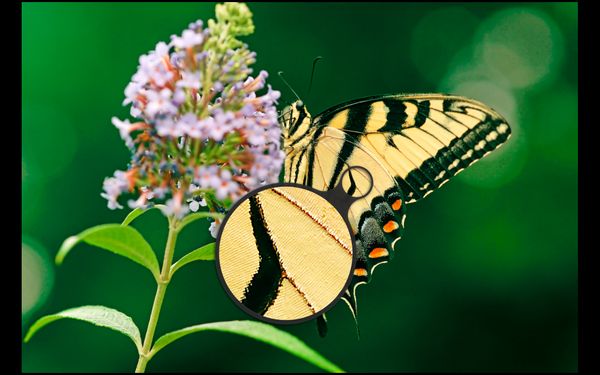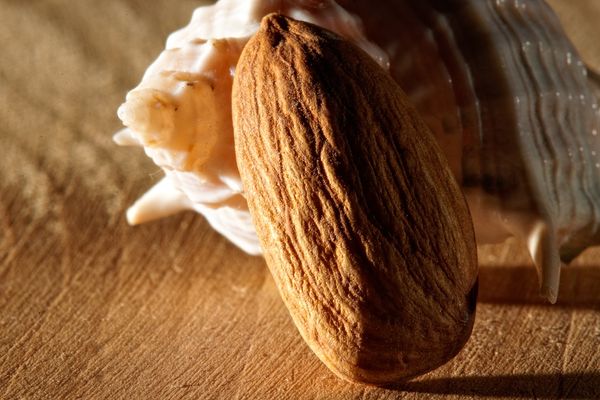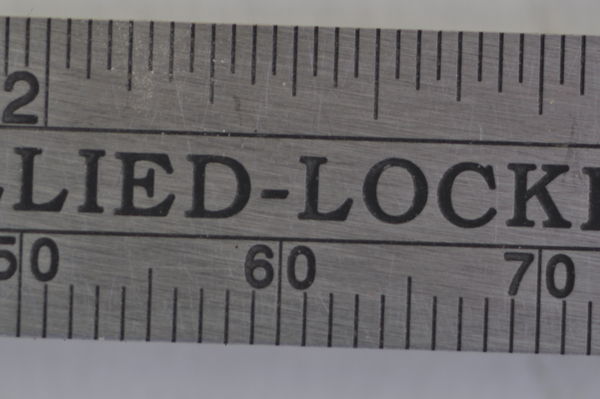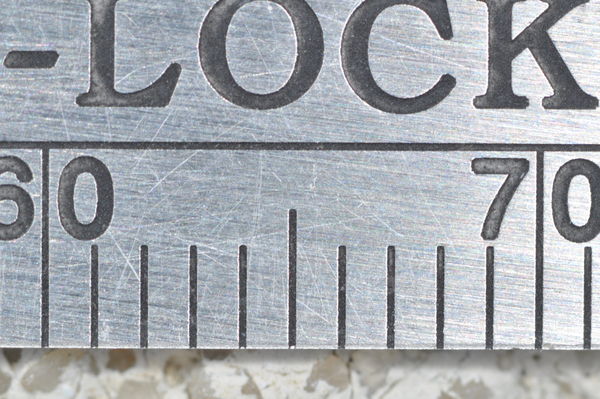Is it macro or not?
Nov 15, 2011 15:28:04 #
I did not post this on the macro tread that is going on now because I do not think it qualifies as a true macro shot. Yes, it was taken with a 100mm macro lens but the lens was not wound out to it's full 1:1 setting because I wanted to capture the entire butterfly. What I find interesting is the detail of the wing structure when the image is blown up large. The camera used a 24.7 MP imaging array. In the attached photo I captured a portion of the wing and magnified it. You can can see at this "Micro" level that a butterfly's wings have structure similar to bird feathers. I did not know this until I blow up this photo to a large print.

Nov 15, 2011 16:07:02 #
I hope that you also captured closer, higher magnification photos of this butterfly, which would be macros, or could be cropped to 1:1 or life-size.
You can also use your 100-mm "macro" lens for portraiture or as a moderate telephoto. A lady's face, or a distant mountain captured with your 100-mm lens does not make those photos macros.
You can also use your 100-mm "macro" lens for portraiture or as a moderate telephoto. A lady's face, or a distant mountain captured with your 100-mm lens does not make those photos macros.
Nov 15, 2011 17:08:45 #
Douglass,
The point I was trying to make is how high resolution imaging arrays and good glass blur the strict definition of macro photography. When you crop and enlarge a small section you can get the effect of a macro shot. Also when you print these photos as 20 by 30 inch prints you start to notice detail that has similar impact to macro. Notice the detail in the magnified circle in the middle of the photo.
BTW, The next thing I'm going to try is to combine Rembrandt lighting with macro/flash photography by using a Ray Flash to control two slave flashes. Look for my post in a few days (If I can do it.)
The point I was trying to make is how high resolution imaging arrays and good glass blur the strict definition of macro photography. When you crop and enlarge a small section you can get the effect of a macro shot. Also when you print these photos as 20 by 30 inch prints you start to notice detail that has similar impact to macro. Notice the detail in the magnified circle in the middle of the photo.
BTW, The next thing I'm going to try is to combine Rembrandt lighting with macro/flash photography by using a Ray Flash to control two slave flashes. Look for my post in a few days (If I can do it.)
Nov 15, 2011 17:22:30 #
maybe this is a different topic, but what is the strict definition of a macro image?
Nov 15, 2011 17:23:26 #
Davethehiker wrote:
The point I was trying to make is how high resolution imaging arrays and good glass blur the strict definition of macro photography.
The is no blur of the definition for macro, which is alway life-size or 1:1 reproduction. Good optics can improve macro-photography and/or close-up photography, but does not blur the distinction. A crisp close-up can be cropped to macro standards, and the cropped image can be considered a macro, but not the original, uncropped image, no matter how good.
For clarity, here are accepted definitions:
True macro is 1:1 or life-size, up to 10:1 or 10x life-size, usually with a macro lens.
True micro is 10:1 or 10x life-size, and higher, usually with a microscope or specialty lens.
Close-up is 1:4 or 1/4 life-size up to near 1:1 or near life-size, with a standard, zoom, or macro lens.
Nov 15, 2011 17:24:47 #
quonnie wrote:
maybe this is a different topic, but what is the strict definition of a macro image?
Thank you for asking! I just posted accepted definitions, directly above.
Nov 16, 2011 06:05:26 #
Self-Education and clear cut simple definitions are important to sound and clear minded discussion of any subject. Here are several references I have read since being in awe of Nikonian's great works:
http://en.wikipedia.org/wiki/Macrophotography
http://www.adorama.com/alc/article/Which-Focal-Length-Macro-Lens-Is-Best-For-You
http://photo.net/learn/macro/
In my youth (last week) I thought a Macro Lens was one that said Macro on the side! Ooops, it is not, rather true Macro lenses, in a sense, are lenses that went thru the lens production line backwards... like with reversing rings permanently mounted... yes an over simplification, but the outer glass, most forward, nearest the subject, is small compared to a "normal" lens which has its big glass forward. These pseudo-macros also do "macro" with a small m (Closeups).
One question for Mr. N... when I photograph a mm scale on a ruler, what should my total image show before crop etc. Should it be equal to or less than (meaning if my sensor is 2.5mm then what shows on the images < or = 2.5) the sensor size. What should I see on the image? i.e. if it showed 0.25 mm then it would be a Macro with a 10:1 magnification? if a 2.5 mm and the sensor 2.5mm then a 1:1 life size? Both would be Macros?
I am currently working with a special adapter snoot for my Panasonic TZ3 with Magnification lenses attached. AND with my Sony DSLR with extension tube. Once I get the definition firm in my mind, then I will show an exciting photo of my ruler. d/p Don
http://en.wikipedia.org/wiki/Macrophotography
http://www.adorama.com/alc/article/Which-Focal-Length-Macro-Lens-Is-Best-For-You
http://photo.net/learn/macro/
In my youth (last week) I thought a Macro Lens was one that said Macro on the side! Ooops, it is not, rather true Macro lenses, in a sense, are lenses that went thru the lens production line backwards... like with reversing rings permanently mounted... yes an over simplification, but the outer glass, most forward, nearest the subject, is small compared to a "normal" lens which has its big glass forward. These pseudo-macros also do "macro" with a small m (Closeups).
One question for Mr. N... when I photograph a mm scale on a ruler, what should my total image show before crop etc. Should it be equal to or less than (meaning if my sensor is 2.5mm then what shows on the images < or = 2.5) the sensor size. What should I see on the image? i.e. if it showed 0.25 mm then it would be a Macro with a 10:1 magnification? if a 2.5 mm and the sensor 2.5mm then a 1:1 life size? Both would be Macros?
I am currently working with a special adapter snoot for my Panasonic TZ3 with Magnification lenses attached. AND with my Sony DSLR with extension tube. Once I get the definition firm in my mind, then I will show an exciting photo of my ruler. d/p Don
Nov 16, 2011 08:38:48 #
Thank you dpullum for the links you provided. The definitions provided in the first link clear up my confusion.
Like you, I to am a big fan of Nikonian's great works.
I learned something new in the first link you provided. I never heard of a "macro coupler"! As I own a huge collection of very good lenses, this device might provide a practical and economical way to take aphid-eye type photos.
Like you, I to am a big fan of Nikonian's great works.
I learned something new in the first link you provided. I never heard of a "macro coupler"! As I own a huge collection of very good lenses, this device might provide a practical and economical way to take aphid-eye type photos.
Nov 16, 2011 12:57:32 #
Purists will tell you that if the subject isn't shown at 1:1 enlargement on the film or sensor, then it isn't macro. Others, myself included, consider a shot as macro if it couldn't have been made with a "standard" lens or kit lens of the type that usually comes with a new camera.
Nov 16, 2011 15:11:59 #
The Rembrandt modified w/ Ray Flash I promised.
1st this is a macro. Remember I'm using a Full Frame camera so I get to call bigger things macro because they do fit within my larger imaging array.
My Minolta/Sony flash system lets me wirelessly control my slave flashes with short (invisible) bursts of light sent from my master/controlling flash mounted on the camera. What is interesting, at least to me, is that I have a Ray Flash mounted on my camera and all these signals are passing through the Ray Flash. I wanted to see if I could control mood lighting in a macro environment using The Ray Flash as just a fill light. I discovered I could!
The first photo shows typical 4:1 Rembrandt lighting. The Ray Flash was not used to illuminate the subject, it just controlled the two flashes that are placed on both sides.
The second photo is much the same but I used a little light from the Ray Flash fill in the shadows.
1st this is a macro. Remember I'm using a Full Frame camera so I get to call bigger things macro because they do fit within my larger imaging array.
My Minolta/Sony flash system lets me wirelessly control my slave flashes with short (invisible) bursts of light sent from my master/controlling flash mounted on the camera. What is interesting, at least to me, is that I have a Ray Flash mounted on my camera and all these signals are passing through the Ray Flash. I wanted to see if I could control mood lighting in a macro environment using The Ray Flash as just a fill light. I discovered I could!
The first photo shows typical 4:1 Rembrandt lighting. The Ray Flash was not used to illuminate the subject, it just controlled the two flashes that are placed on both sides.
The second photo is much the same but I used a little light from the Ray Flash fill in the shadows.


Nov 16, 2011 17:00:35 #
David who hikes; has a Sony. Yes, the coupler, about $10 fools the Alpha into thinking there is a lens on the camera that is a Minolta. I have a Sony adapter with a M-42, Pentax, etc screw mount lens, so conceivebly a lens 70+ years old will work. I have a 200 mm and a 50mm 1.2:1 lens that will work manual. I have ordered another sony adapter with a 49mm adapter for a 50mm M42 lens that I have. That lens will be a good candidate for reversal.
I built a snout on my Panssonic for 58mm filters and tried using a stack of close up lenses, it works. So eventually, I will have some low cost first class equipment and be able to contribute some good photos.
Hay, one other thing, tilt mount the lens to change the plane of the subject/plane of the "film" thus the focus is fooled into thinking it is in focus tho it is further from the "film" than the other end of the long bug. I will work on the design. Planning to fix my old bellows to work using car defroster air hose which has a spiral wound wire in it. such a hose will be about the right size and can be mounted in some way and painted black to block light.
If i am ambling,, forgive me,,,taught school today.
I built a snout on my Panssonic for 58mm filters and tried using a stack of close up lenses, it works. So eventually, I will have some low cost first class equipment and be able to contribute some good photos.
Hay, one other thing, tilt mount the lens to change the plane of the subject/plane of the "film" thus the focus is fooled into thinking it is in focus tho it is further from the "film" than the other end of the long bug. I will work on the design. Planning to fix my old bellows to work using car defroster air hose which has a spiral wound wire in it. such a hose will be about the right size and can be mounted in some way and painted black to block light.
If i am ambling,, forgive me,,,taught school today.
Nov 16, 2011 17:22:05 #
dpullum wrote:
One question for Mr. N... when I photograph a mm scale on a ruler, what should my total image show before crop etc. Should it be equal to or less than (meaning if my sensor is 2.5mm then what shows on the images < or = 2.5) the sensor size. What should I see on the image? i.e. if it showed 0.25 mm then it would be a Macro with a 10:1 magnification? if a 2.5 mm and the sensor 2.5mm then a 1:1 life size? Both would be Macros?
For my own benefit, I photographed a ruler with my macro lens. I manually set my lens at closest focus, then move camera and lens in-&-out until focus was established. Standard extension tube lengths are 12-mm, 20-mm, & 36-mm, which can be used individually or in combination.
My Nikkor CMOS sensor is 23.6-mm x 15.8-mm. Recording a 24-mm wide image is basically 1:1 or life-size. The eyepiece shows the same view as the sensor captures.
105-mm field of view = approx. 1:1 (23.5-mm x 15.7-mm)

105-mm field with 68-mm tubes = 4:1 (11.9-mm x 7.9-mm)

Nov 16, 2011 17:39:19 #
Davethehiker wrote:
1st this is a macro. Remember I'm using a Full Frame camera so I get to call bigger things macro because they do fit within my larger imaging array.
I suggest that you photograph a metric ruler so that you can document your photographed field and compare to original. If you have extension tubes, or bellows, do the same.
Nov 16, 2011 20:19:40 #
The specs for the A900 state:
The DSLR-A900 starts with a 24 x 35.9mm size CMOS sensor developed especially for this camera.
Below is the resulting photo when a 100mm macro is turned as far as it will go (a tiny bit past 1:1):
I notice that a tiny bit is trimmed off the edges of the original photo when it uploaded to Ugly Hedgehog.
My take from this is that my lens goes a little past 1:1 i.e. "1:0.99". I can get the 35.9 by simply turning the lens a little bit (still on the 1:1 mark).
The DSLR-A900 starts with a 24 x 35.9mm size CMOS sensor developed especially for this camera.
Below is the resulting photo when a 100mm macro is turned as far as it will go (a tiny bit past 1:1):
I notice that a tiny bit is trimmed off the edges of the original photo when it uploaded to Ugly Hedgehog.
My take from this is that my lens goes a little past 1:1 i.e. "1:0.99". I can get the 35.9 by simply turning the lens a little bit (still on the 1:1 mark).

Nov 16, 2011 20:25:10 #
Davethehiker wrote:
The specs for the A900 state:
The DSLR-A900 starts with a 24 x 35.9mm size CMOS sensor developed especially for this camera.
Below is the resulting photo when a 100mm macro is turned as far as it will go (a tiny bit past 1:1):
The DSLR-A900 starts with a 24 x 35.9mm size CMOS sensor developed especially for this camera.
Below is the resulting photo when a 100mm macro is turned as far as it will go (a tiny bit past 1:1):
Interesting!
On your FX (full size) sensor using a 100-mm lens, you can capture 1:1, or life-size.
On my DX (smaller) sensor using a 105-mm lens, I also capture 1:1, or life-size.
If you want to reply, then register here. Registration is free and your account is created instantly, so you can post right away.




